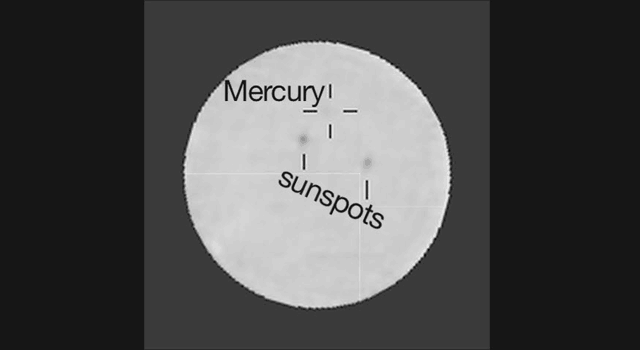|
Transit Of Mercury From Mars
frameless, upright=0.5 A transit of Mercury across the Sun as seen from Mars takes place when the planet Mercury passes directly between the Sun and Mars, obscuring a small part of the Sun's disc for an observer on Mars. During a transit, Mercury can be seen from Mars as a small black disc moving across the face of the Sun. Transits of Mercury from Mars are roughly twice as common as transits of Mercury from Earth: there are several per decade. Transit The Mars rovers ''Spirit'' and ''Opportunity'' could have observed the transit of January 12, 2005 (from 14:45 UTC to 23:05 UTC); however the only camera available for this had insufficient resolution. They were able to observe transits of Deimos across the Sun, but at 2' angular diameter, Deimos is about 20 times larger than Mercury's 6.1" angular diameter. Ephemeris data generated bJPL Horizonsindicates that ''Opportunity'' would have been able to observe the transit from the start until local sunset at about 19:23 UTC, while ... [...More Info...] [...Related Items...] OR: [Wikipedia] [Google] [Baidu] |
Transit Of Earth From Mars
frameless, upright=0.5, right A transit of Earth across the Sun as seen from Mars takes place when the planet Earth passes directly between the Sun and Mars, obscuring a small part of the Sun's disc for an observer on Mars. During a transit, Earth would be visible from Mars as a small black disc moving across the face of the Sun. They occur every 26, 79 and 100 years, and every 1,000 years or so there is an extra 53rd-year transit. Conjunctions Transits of Earth from Mars usually occur in pairs, with one following the other after 79 years; rarely, there are three in the series. The transits also follow a 284-year cycle, occurring at intervals of 100.5, 79, 25.5, and 79 years; a transit falling on a particular date is usually followed by another transit 284 years later. Transits occurring when Mars is at its ascending node take place in May, those at descending node happen in November. This cycle corresponds fairly closely to 151 Mars orbits, 284 Earth orbits, and 133 synodic pe ... [...More Info...] [...Related Items...] OR: [Wikipedia] [Google] [Baidu] |
Monthly Notices Of The Royal Astronomical Society
''Monthly Notices of the Royal Astronomical Society'' (MNRAS) is a peer-reviewed scientific journal covering research in astronomy and astrophysics. It has been in continuous existence since 1827 and publishes letters and papers reporting original research in relevant fields. Despite the name, the journal is no longer monthly, nor does it carry the notices of the Royal Astronomical Society. History The first issue of MNRAS was published on 9 February 1827 as ''Monthly Notices of the Astronomical Society of London'' and it has been in continuous publication ever since. It took its current name from the second volume, after the Astronomical Society of London became the Royal Astronomical Society (RAS). Until 1960 it carried the monthly notices of the RAS, at which time these were transferred to the newly established ''Quarterly Journal of the Royal Astronomical Society'' (1960–1996) and then to its successor journal ''Astronomy & Geophysics'' (since 1997). Until 1965, MNRAS ... [...More Info...] [...Related Items...] OR: [Wikipedia] [Google] [Baidu] |
Albert Marth
Albert Marth (5 May 1828 – 6 August 1897) was a German astronomer who worked in England and Ireland. Life After studying theology at the University of Berlin, his interest in astronomy and mathematics led him to study astronomy under C. A. F. Peters at the University of Königsberg. Marth went to England in 1853 to work for George Bishop, a rich wine merchant and patron of astronomy, who financed a London observatory (in operation from 1836 to 1861). At that time, paid jobs in astronomy were quite rare. He worked as William Lassell's assistant in Malta, discovering 600 nebulae. He also discovered one of the earlier asteroids found, 29 Amphitrite, and the galaxies NGC 3, NGC 4 and NGC 15. He also did work in double stars, discovering NGC 30 in 1864. From 1883 to 1897 he worked at the Markree Observatory in Ireland where he was the second director appointed in its second period of operation. He made extensive ephemerides of Solar System bodies. He even performed calcul ... [...More Info...] [...Related Items...] OR: [Wikipedia] [Google] [Baidu] |
Transit Of Mercury From Earth
frameless, upright=0.5 A transit of Mercury across the Sun takes place when the planet Mercury passes directly between the Sun and a superior planet. During a transit, Mercury appears as a tiny black dot moving across the Sun as the planet obscures a small portion of the solar disk. Because of orbital alignments, transits viewed from Earth occur in May or November. The last four such transits occurred on May 7, 2003; November 8, 2006; May 9, 2016; and November 11, 2019. The next will occur on November 13, 2032. A typical transit lasts several hours. Mercury transits are much more frequent than transits of Venus, with about 13 or 14 per century, primarily because Mercury is closer to the Sun and orbits it more rapidly. On June 3, 2014, the Mars rover ''Curiosity'' observed the planet Mercury transiting the Sun, marking the first time a planetary transit has been observed from a celestial body besides Earth. Scientific investigation The orbit of the planet Mercury lies interio ... [...More Info...] [...Related Items...] OR: [Wikipedia] [Google] [Baidu] |



